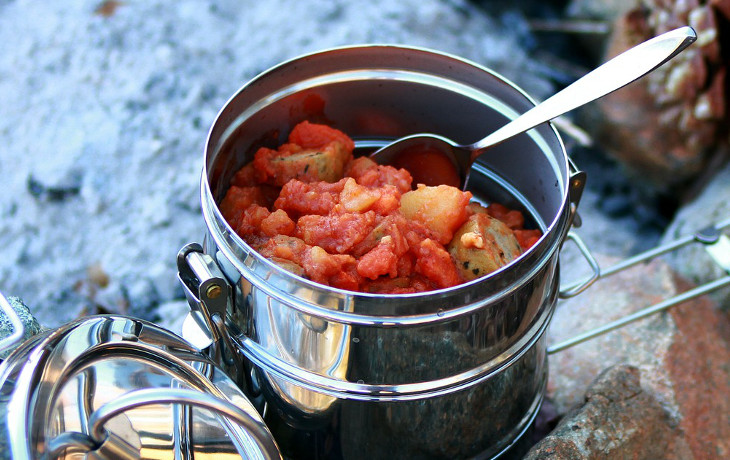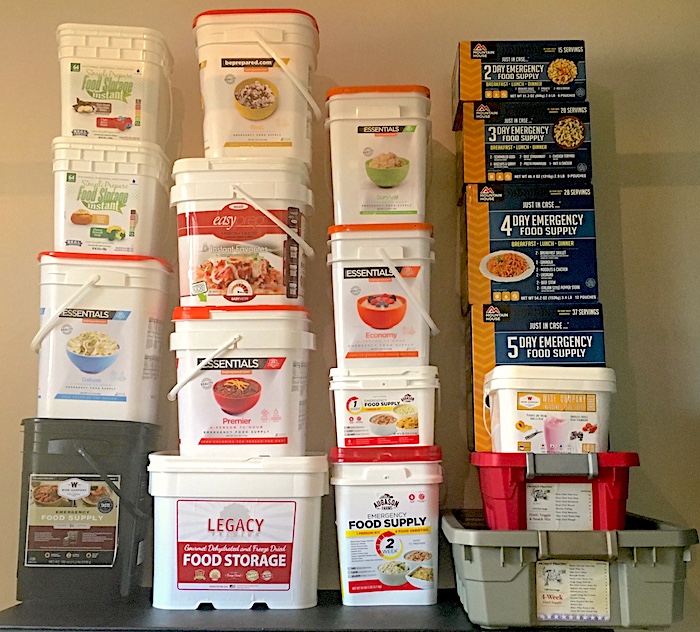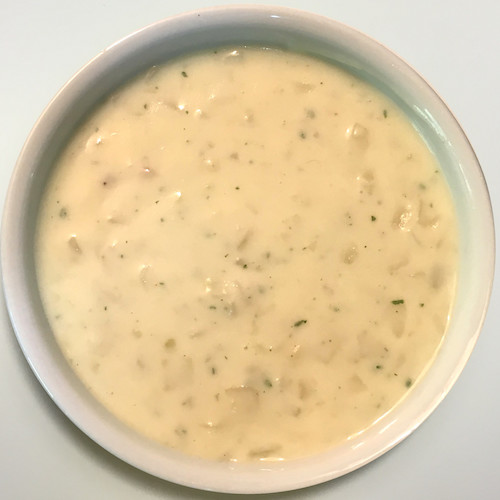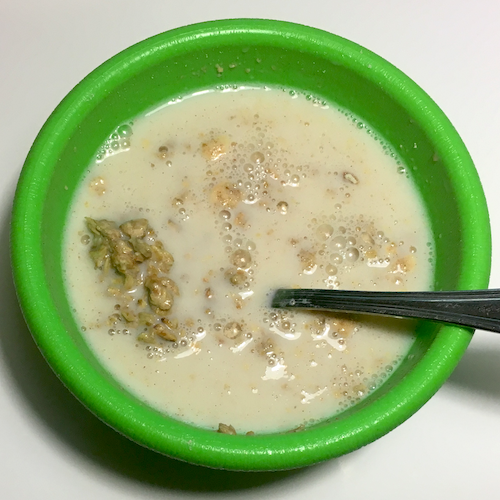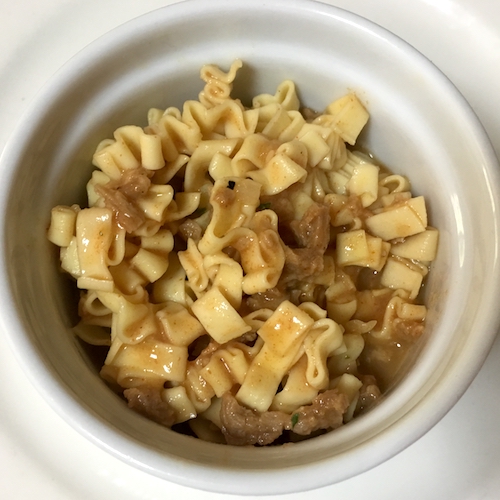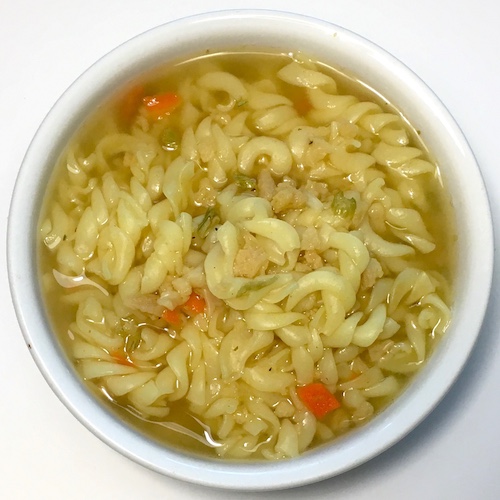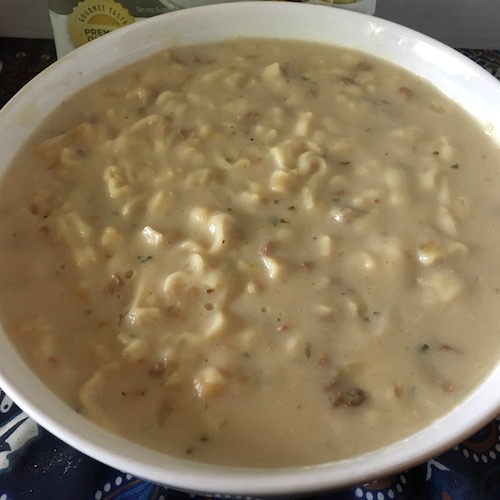Be prepared. Don’t be a victim.
Want more great content and giveaways? Sign up for The Prepared’s free newsletter and get the best prepping content straight to your inbox. 1-2 emails a month, 0% spam.
If a disaster such as an earthquake knocks out power and water, how will you eat? What if the local food supply is disrupted and store shelves are empty?
As we’ve seen after the nasty 2017 hurricanes, one storm alone can cause weeks or months of havoc. Some simple preparations can make the difference between “no big deal” and “total life disruption.”
More: The best MREs
We often hear from everyday people who benefited from their survival food in situations like sudden job loss, unexpected expenses that throw off a budget, winter storms, and all kinds of natural disasters. We’ve even heard from some whose local food supply was temporarily spoiled or tainted and they wanted to play it safe.
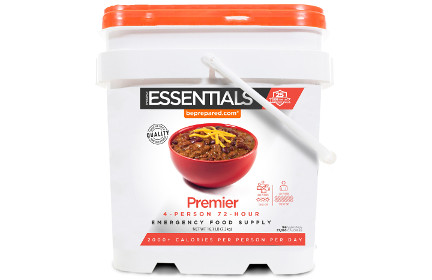
Best option for most:
Emergency Essentials 2 Week Kit
(Editor’s note June 2019: Emergency Essentials remixed their product naming and SKUs. The three-bucket “Premier” combo is still available, but they dropped the Premier label for the single bucket. We’ve updated the single-bucket link to the comparable product in the meantime.)
The Emergency Essentials 2 Week ~True Survival~ Food Kit is the best short term emergency food product for most people. The $200 kit option covers two people for 15-18 days at a very healthy 2,388-1,857 calories per day.
A new product line from an established company, we were really impressed with Emergency Essentials’ overall value, flavor, calorie count, nutritional value, meal variety, and clear communication around product options. Other companies did better in a few different aspects, but we felt this did the best job for most people.
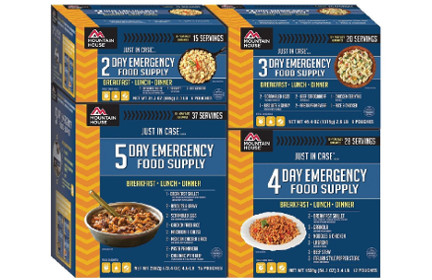
Tasty and convenient:
Mountain House Just-in-Case 14-Day Combo
If you ignore the price, the best overall survival food is the Mountain House 14-Day Just-in-Case Emergency Food Supply Combo. $280 covers one person for two weeks, or $480 for two people, at around 2,100 calories per day — although MH could do a lot better job clearly explaining the calories per day in their survival bundles.
Our testers unanimously voted MH the best tasting, even going as far as to buy some to use in everyday life. Nutritionists we spoke with thought MH had the best overall nutritional value, too, with tons of meat-based proteins and fiber. It’s also the most convenient to cook. No external dishes needed, just pour some (ideally boiling) water into the pouch, let it cook, eat, then trash.
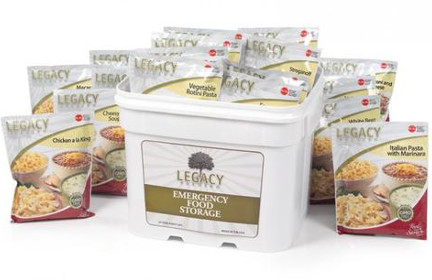
Great for vegetarians / base:
Legacy Foods 120 Serving Bucket
Legacy Foods 120 Serving Breakfast, Lunch, and Dinner Bucket is a great option for vegetarians or people who want more of a bland foundation that you mix with other ingredients. For $299, one bucket covers two people for two weeks at 1,500 calories per day. Although other companies drop the calories to cut costs, Legacy assumed you would add more ingredients to their base, so we thought the relatively low calories per day was acceptable.
A very healthy, non-GMO, zero high-fructose corn syrup option with generous portions and decent amounts of fiber and protein for a meatless product. We also thought the storage bin was the best of the group. Legacy also offers a gluten-free option.
- Why you should trust us
- Two weeks of survival food for two people
- Buying turnkey products vs. doing it yourself
- Role of nutrition in an emergency
- How we judged survival food
- Which food we picked for testing
- How we tested
- Comparison summary between products
- Our pick: Emergency Essentials Premier
- Upgrade pick: Mountain House 14-Day Just in Case Combo
- Vegetarian pick: Legacy Foods Breakfast, Lunch, and Dinner
- Great add-on: My Patriot Supply Fruit, Veggie, and Snack Mix
- Review notes on each product and how they compare
- Supplemental shakes for extra nutrition
Why you should trust us
We spent almost 200 hours testing over $2,000 worth of food from the top seven companies — and yes, we have the time logs to prove it. We spent this time researching, interviewing experts, comparing nutritional labels, testing containers and packaging, preparing and tasting food, and documenting results.
Food testing was conducted in real homes by 16 people with a wide range of age and cooking ability, including a professionally trained chef, families with small children, and people who can’t cook at all. Some testers were prepping pros. Others had never even heard of preppers.
Ironically, this test got easier to do, because during evaluation one family had to evacuate due to one of the natural disasters in the Fall of 2017 🙁
We researched all of the commonly available 15- to 30-day emergency meal kits and physically tested ones from the seven companies whose products lined up with our specific requirements.
We corroborated our research with experts, including nutrition sciences professors LesLee Funderburk, Ph.D., and Robin Polokoff, Ph.D..
Most importantly, we actually opened the packages of food, prepared, and ate them. (Believe it when we say we don’t want to eat more mac and cheese for a lonnng time!)
Aside from writing and editing professionally, Janna Balthaser has 30 years of experience as a trained cook. She has used freeze-dried camping and emergency food regularly for a decade, and has studied nutrition extensively in an academic setting.
Emergency food for two people over two weeks
Emergency experts strongly recommend that everyone have enough supplies to last at least two weeks — not the old advice of 72 hours. We’ve seen too many disasters that took more than three days to recover.
Many food products will market themselves around a 4 week / 30-32 day / 1 month timeline for one person. This was fine for us, because we standardize against two weeks but assume that an average household is two people. So it’s easy to buy a “30-day supply for one person” — assuming the calories per day are appropriate — and use it as a two-week supply for two people.
If you live alone, be aware of whether a product that’s labeled by length of time is intended for one or two people, pay attention to the calories, and adjust accordingly. It’s always OK to end up with 30 days worth of food instead of 15.
Buying prepper food products vs. doing it yourself
There will be preppers who read this review and say things like: “Poppycock! Why spend $400 on food? I can do some hunting and preserve the meat. I’ll get some bags of rice and spend a few weekends canning vegetables.”
Which is perfectly fine — but that’s not the point of this review. Many people want to click and buy a product that fills the need quickly and correctly. Maybe saving $100 isn’t worth all the extra work. Many of us barely have time to spend a few moments with our families and get some sleep before we have to get up and go to work.
There are two main DIY paths:
- Buy enough dry goods like rice and beans to last two weeks. Have a stocked pantry. Continually cook, eat, and replace those supplies so that there’s always two weeks’ worth, but they’re used before they expire.
- Canning, preserving, dehydrating, home freeze-drying, etc.
The first option is OK, but in practice we find that most people are bad at maintaining the constant use-and-replenish cycle. This inevitably results in either not having enough of the right supplies or having expired food at the time you need it most. A good prep is always ready, no matter what.
Even if you DIY, it’s still a good idea to buy these two-week survival kits
We think there’s a much more valid debate between DIY and different types of products once we get outside this basic two-week window.
If things are so bad that you need months or years of food, there are multiple ways to solve those problems and you probably can’t just rely on the freeze-dried stuff — you will want ways to grow, catch, hunt, preserve, and cook your own food.
But for the majority of likely emergencies scenarios, where two weeks is all you need, we think food is so important that it’s worth having these products on hand — even if you still do lots of cooking and canning in normal life anyway.
Your shelf full of cans can easily fall and break, and they’ll be difficult to grab when you need to bug out in a hurry.
These sturdy buckets and totes will survive things like floods and earthquakes. They’re easy to transport. Some of the pouches are designed for cooking, so you don’t even need any extra utensils. And you can reuse the containers for things like food or waste when they’re empty.
We’re assuming that you have some normal food in your home
Although the average person is woefully unprepared, most have at least some food around the house.
Using our experience as prepping teachers and data about the types and amounts of food commonly found in an American pantry or fridge at any given time, we assumed that people have around two days’ worth of things like a bag of rice, peanut butter, some frozen chicken, and canned soup.
Think of those random leftovers as a bonus on top of these survival food products. An average household’s pantry isn’t nearly good enough to sustain two weeks of no-grid survival. Especially when you exclude things that perish or need microwaving and proper cooking.
But the extra stuff you have around can make things tastier and more nutritionally complete. We took that into account for this review.
Role of nutrition in emergency survival food
Nutrition matters more in an emergency, not less — even when the flood waters are at your door.
Sure, some people plan on surviving off junk food, beef jerky, ramen noodles, and packets of peanut butter and raisins for a few weeks. It won’t kill you, but if you don’t have to, would you still want to?
An emergency is exactly the time when you need your body and mind to be at their best. You have enough to worry about in a crisis. Don’t add diarrhea and mental fog to the mix.
If you don’t give your body the vitamins and minerals it needs, your immune system gets weak and you can get sick. A lack of fiber, combined with unusual or junky food, can cause severe digestive problems. At best, you’ll feel lethargic, fuzzy, moody, have even more trouble sleeping, trouble making intelligent decisions, and other ill effects.
According to the World Health Organization, children, pregnant mothers, people over 65, and people with existing medical conditions are particularly vulnerable to malnutrition. Even temporary malnutrition can have irreversible effects on children, reducing their physical and mental potential for a lifetime.
This is why we took the time to understand the practical goals of nutrition in an emergency and look at these products for their nutritional value, not just flavor, price, and convenience.
LesLee Funderburk, Ph.D., a registered dietician and nutrition sciences professor at Baylor University, told The Prepared: “Stress generally causes an increase in epinephrine and cortisol to prepare the body for the ‘fight or flight’ response. This would increase our metabolic rate and heart rate.”
Dr. Robin Polokoff, Ph.D., a nutrition professor at Diablo Valley College, echoed the same, telling us that during during times of stress our bodies need more of everything, because our metabolic rate shoots up.
Compared to the 2,000 calories per day baseline in normal life, experts know that caloric needs can vary wildly in an emergency scenario.
According to Funderburk, “if you are literally in a shelter with little movement, then depending on the person, you could survive on 1,200-1,500 kcal per day versus someone that is out with constant movement [who might need] ~3,000 calories plus.”
Since some food companies think 800-1,200 calories counts as a day’s worth of food, we wondered about the consequences of calorie deficiencies and how quickly you would feel them.
Funderburk explained that after 3-7 days, your body will start to use carbs stored in body fluid (glycogen), which results in an immediate loss of fluids. In addition to a rapid loss of a few pounds of fat and general fatigue, at 15 days you’ll start to notice muscle loss as your body cannibalizes muscle for protein.
It wasn’t a surprise that calories for energy was the most important factor, but we were personally surprised to hear how much experts focused on protein in an emergency. They told us to ignore daily-life villains like sugar in exchange for more protein — ideally reaching 50-65 grams per day.
Dr. Polokoff also recommended keeping an eye on the percentage of calories from simple (“empty”) carbs and reaching at least 25 grams of fiber per day for women / 36 for men.
Although it’s good to avoid high-sodium foods in daily life, we didn’t treat salt as a big negative in this review. Salt is a preservative, and that’s important in foods designed to last 25+ years.
How we reviewed emergency preparedness food
It might seem like there are a lot of different ways to answer the question “What is the best way to meet off-the-grid food needs for two weeks?”
To pick the best short-term food supplies, our experience, research, and experts settled on these criteria:
- Doesn’t depend on anything else — no hunting, foraging, stealing, other products, etc.
- Complete and easy to buy from reputable companies
- Shelf life of at least 10 years
- Easy to store and transport
- Packaged in individual pouches, not #10 cans or large bags
- Durable packaging that can survive common emergencies
- Easy to use in an emergency situation
- Enough calories and satiability (beats hunger)
- Taste
- Variety
- Nutritional content
- Cost-effectiveness
Complete meals and easy to buy: Buy one product and be done, rather than piece together different portions and ingredients.
This also disqualified the DIY options because, while fine in their own right, they take too much time or money for most people to consider.
All but one of the options we picked for testing were complete. One product was designed to be a base, where you add your own protein source. We still tested that option because it might’ve been good enough anyway or a good option for vegetarians.
Shelf life: Most of the freeze-dried options last 25-30 years when stored properly. Other options, like MREs and meal replacement shakes like Ensure, have a shelf-life below our 10-year cutoff. For example, Soylent is a great product, but lasts less than two years.
Easy to store and transport: You might store and forget about these products for several years because of their long shelf-life, so we looked for products that stored well. An admittedly subjective measurement, but one we thought was important enough to consider.
Durable packaging: Can it hold up to abuse, floods from storms, etc.? For example, the biggest danger during an earthquake is things falling. Since it’s easy to imagine storing supplies like this on the bottom shelf in a garage, consider how it would hold up to stuff falling on top of the container, or to flood water coming in. Or zombies… those sneaky zombies.
Individual pouches: For this use-case, we prefer packages where one pack equals one meal or serving. Pouches are easier to store, can often be used to cook the meal without any other utensils, are more portable, don’t need a can opener, can be traded, and have other desirable qualities. No. 10 cans, which are like big coffee cans, are great for staple ingredients like flour or corn.
Cost-effectiveness: We didn’t set a budget or have predetermined criteria. Instead, we looked at the relative cost between products when considering things like taste and calorie count.
Easy to use in an emergency: People often underestimate how nasty things can be in a crisis. Unfortunately, we’ve worked with preppers whose entire food plan was based on assumptions like having time to run to the store before a crisis, having gas running to the kitchen stove, or having a stocked fridge.
We considered the full range of emergency scenarios where you’d use this food, along with the common equipment found in typical bug out bags and emergency shelters. It’s always better to keep the effort and gear needed for preparation, cooking, utensils, cleanup, and so on to a minimum.
Variety: We looked for products that had a nice mix of breakfast, lunch, dinner, and even snack foods that didn’t rely on the same fundamentals for each meal (like rice and beans).
Calories and satiability: Some companies play marketing games with “servings” and number of days a product will support you. Or they won’t disclose calorie counts at all. So it’s important to pay attention to total calories and calories per day in an emergency food product — otherwise, it’s not an apples-to-apples comparison.
For example, some companies will say “this product is enough food for 7 days!” But they base their math on 1,400 calories per day (or less), or they rely on you to add supplemental ingredients to their base.
Nutrition: We researched where it was acceptable to cut corners and how to prioritize emergency nutrition needs.
We added up all the data for calories, carbs, protein, fat, added sugar, and fiber for each product. We shared that data with nutrition experts, who helped us judge the quality and value of each product. We’ll spare you the data details, but know it factored into our decisions.
The FDA is making significant changes to nutritional label laws that are rolling out over 2017 to 2018. Because some manufacturers have changed early and others haven’t, in some cases we couldn’t be as apples-to-apples in our data analysis as we’d like, particularly around vitamins and minerals. So we did some backdoor math by judging the amount of fruits and vegetables in each meal.
Since emergency freeze-dried food tends to be low in all nutrients except simple carbs, we also looked into ways to supplement protein, vitamins, and minerals. So we tested a couple of shake mixes and dehydrated/freeze-dried fruits and vegetables, to offer you a couple of ways to boost flavor and nutrition on top of the core food buckets.
Which survival food kits we tested
After reviewing over 20 different possible off-the-shelf options found on survival websites and traditional stores like Amazon and Costco, we settled on testing options from these 7 companies in person:
- Augason Farms * 1-week 1-person + 2-week, 1-person
- Legacy Foods 120-serving Breakfast, Lunch, and Dinner Bucket
- Mountain House 14-Day Just-in-Case Emergency Food Supply Combo
- My Patriot Supply 4-Week Food Supply & Fruit, Veggie & Snack Mix
- Ready Store EasyPrep Ultimate 1-month Food Storage Kit
- Wise Foods Emergency Freeze Dried Breakfast and Entree Bucket
- Emergency Essentials Survival, Economy, Basic, Deluxe, Premier Buckets
*We wanted to test the Augason Farms 30-day bucket, but due to the 2017 natural disasters driving up demand for emergency food, we couldn’t get that exact one in time for this article. Instead, Augason sent us a 1- and 2-week bucket, which together have the same food as the 30-day. We used the nutritional data from the 30-day bucket in our analysis.
We’d like to thank the kind folks at each company for contributing free products for this test. They all knew and respected that, unlike many other sites, our Prepared Promise means free evaluation products will never affect our recommendations.
It’s great when companies will take a risk by putting their product up for a comparison review, because in the end it makes the whole community better and can provide actionable feedback on their products. Reviewing one product in a vacuum doesn’t really help you decide what to buy. So give them a thanks and a follow on social media.
We also tested these shakes and supplements to round out the nutritional gaps in the main buckets:
- Soylent Meal Replacement Drinks
- Tsogo Protein Shakes
- Wise Foods Emergency Meal Replacement Shakes
- Simpli Prepare Shakes
- Simpli Prepare Soups
We did not choose some otherwise popular products because they didn’t meet our criteria. For example, some companies sell a range of individual packets that you mix and match. Those didn’t qualify because we were looking for a simple one- or two-click purchase to get you what you need.
What about MREs (Meals Ready to Eat)?
Here’s a separate review of the best MREs. They are not nearly as appropriate for at-home long-term food storage — at best, they can work in portable situations like your go-bag or car supplies.
How we tested the top survival food products
Cooking and tasting
Our group of 16 testers ranged from 2-65 years of age, with every demographic represented (1-12, 13-17, 18-24, 25-34, 35-44, 45-54, 55-64, 65+).
Their cooking abilities ranged from microwaving to grinding wheat for homemade bread, with home cooks and a professional chef in between.
Vegetarians, meat lovers, picky kids, die-hard foodies, junk food junkies, and health nuts were all in the mix. There were people with little money, and those who can afford to eat whatever they want. People who consider themselves serious preppers, to people who hadn’t even heard the term before.
We followed all manufacturer instructions. Water was boiled in a kettle, a pot on electric and gas stoves, or a Coleman camp stove with propane canisters.
Families tried the foods at home, preparing them in their own kitchens (or in the case of the camp stove, their back yard) just like they would use them in an emergency hunker-down situation.
We did find that almost every product tasted better if you let it cook longer and used less water than the instructions said.
There are some commonly found meals among survival food. Partly because of the processes and chemistry involved, some things like chicken and rice are easier than other dishes, and thus more common. These companies also want to give people familiar, comforting food. So they don’t mess around with less common recipes or flavor profiles.

We kept thorough tasting notes for each meal — ending up with another 6,000 words beyond this article — describing people’s feedback on ease of cooking, taste, overall happiness with the meal, photos of preparation and finished product, and so on.
To accurately compare the difference in taste between products, we ran tests on the flavors that were available in most or all of the products.
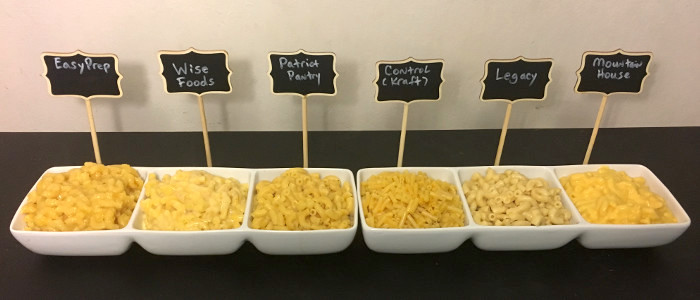
Packaging, storage, and portability
Because it’s important that your food is useful no matter what is happening around you, we tested containers for durability, water resistance, ease of storage, and portability.
Most products come in a plastic bucket with lid. The My Patriot Supply option comes in a flatter tote, that while a little flimsy, fits very well under a bed. Mountain House sends cardboard boxes, unless you get their 3-day Just In Case Essentials or Classic Buckets.
To test the containers for water resistance, we put them in a full bathtub upside down, and sprayed them with a garden hose with a high-pressure nozzle.
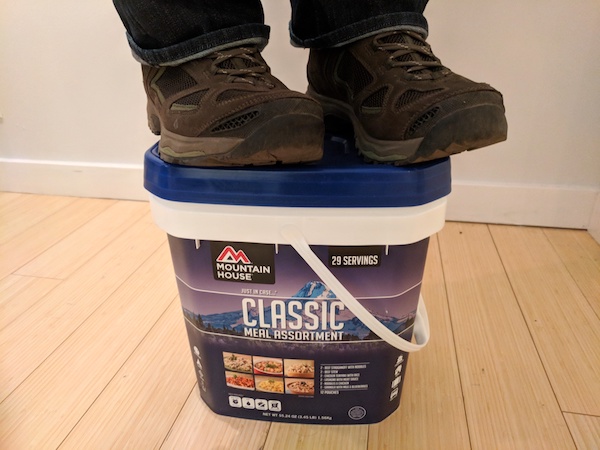
To test for durability, we stacked two wine cases on them (90 pounds), and had a 250 pound man stand on them with both feet.
Most of the products we tested resisted water intrusion and would hold up well if stuff fell on it in an earthquake.

The MPS totes let in a little water when we submerged them. And the tote lid bent a little under the weight testing, but did not collapse or hurt the food. As expected, the cardboard boxes containing Mountain House foods got soggy immediately. But the packets of food themselves are waterproof. The boxes stacked well but didn’t offer nearly the same protection as the buckets.
Every option we tested was stackable and storable. We had multiple people try to store the packages around their house. Do they fit easily under a bed? In a normal closet? On a typical garage or basement shelf?
A nice bonus with all the plastic containers is that you can re-use them for other needs, survival or normal life. They can store clothing, food, supplies — or even be turned into a toilet.
We also evaluated them for portability. Not just for how easy they are to move normally, but also in situations where you need to bug out quickly and want to grab some food to throw in the car. The heaviest container was 28 pounds, so this isn’t a problem.
Comparing survival food products
We’d be happy to have any of these top products in an emergency — each of them are better than the majority of alternatives we see people hack together (or none at all).
While some clearly stood out in our overall recommendations, each product had some characteristic that stood out against the others.
If The Prepared had a yearbook, this would be our list of superlatives:
- Best tasting: Mountain House
- Most customizable: Emergency Essentials
- Highest nutritional content: Mountain House
- Best traditional comfort food: Wise Foods (Chicken Noodle Soup)
- Best cold cereal: Ready Store (Apple Cinnamon Granola)
- Best hot cereal: Legacy Foods 9-Grain Cereal
- Easiest to prepare/most convenient: Mountain House
- Best pancakes: My Patriot Supply
- Best soups overall: Augason Farms
- Most durable container: Legacy Foods and Ready Store (tie)
- Best for omnivores: Mountain House
- Best for people who like to cook: Legacy Foods
- Best for people who don’t want to cook: Mountain House
- Best for vegetarians: Legacy Foods
- Most versatile container: My Patriot Supply
- Best whey-based beverage/milk: Augason Farms (Morning Moo)
- Most affordable: Augason Farms, Ready Store, Wise, and EE (Survival), depending on sale prices
- Best supplement of freeze-dried food: My Patriot Supply (fruit/veg/snack tote)
Price of emergency food
It’s hard to compare because these companies frequently run sales or play games with “markdowns” that are essentially permanent. While writing this article, we saw price fluctuations up to $100.
As of publishing, this was the cost for two people for two weeks and per calorie price for each product. To keep it apples-to-apples, in some cases we priced based on two buckets instead of three (in the Emergency Essentials example) to get the per-day calorie count roughly similar.
| Brand | # of buckets | 2 people for 2 weeks | Price per 2000 calories |
|---|---|---|---|
| Augason Farms | 1 | $99 at 1822 cal / day | $3.60 |
| Emergency Essentials (Premier) | 2 | $260 at 1822 cal / day | $9.40 |
| Mountain House (14-day Combos) | 2 | $480 at 2150 cal / day | $14.80 |
| My Patriot Supply | 2 | $460 at 2030 cal / day | $15.00 |
| Legacy Foods | 1 | $299 at 1488 cal / day | $13.40 |
| Ready Store / EasyPrep | 2 | $396 at 2070 cal / day | $12.80 |
| Wise Foods | 3 | $390 at 1992 cal / day | $13.00 |
Nutrition
Every product we found would be considered “not good enough” from a purely nutritional perspective. Generally, each was too low in protein, fiber, vitamins, and minerals to be considered a sole but complete source of food for a few weeks.
Between the food we assume is on an average pantry shelf, and the supplemental shakes and add-ons we recommend below (like the $99 Fruit, Veggie and Snack Mix from My Patriot Supply), that should be enough to cover all the important needs for two weeks.
That said, our calculations showed Mountain House had the best overall nutrition. Nutrition experts looked over the figures and agreed. The least nutritious is Wise, mostly because of the low calorie count and other macronutrients.
Mountain House, Augason Farms, and Emergency Essentials are highest in calories, at an average close to 2,000 per day. They are also the three highest in protein and fiber. Mountain House has the most protein and Augason Farms has the most fiber.
Mountain House has the most fat, averaging around 73 grams per day. But it has actual meat and cheese. Experts recommend getting 20-35% of calories from fat, so MH’s 35% was acceptable. Wise has the lowest average fat per day, but that’s because it’s just low on food in general, with a calorie count 2.5 times lower than MH.
The Legacy option is the healthiest. Vegetarian, non-GMO, no MSG or high-fructose corn syrup, no cheap TVP meat substitutes, high in fiber, etc.
Many of the popular survival food products fell short of the recommended daily minimum of 2,000 calories — some by a lot. This was to the point that nutrition and emergency experts felt that some options were just not acceptable.
Transparency in marketing
There are a lot of marketing games about “servings” and the number of days a product will support, which made this review much more complicated than it needed to be.
In general, Augason Farms, Emergency Essentials, and Legacy Foods make it easy to understand the calories in a product, and they do a reasonably fair job of labeling how many days a bucket covers at a reasonable amount of calories (over 1,800).
Although, Legacy heavily promotes that they have the best price per 2,000 calories in the industry, which is not true in this category.
Mountain House, Wise Food, My Patriot Supply, and Ready Store need to get better in this regard. In some cases, we had to call a company and dig deeper than reasonable in order to find out calorie content — or we had to look at individual nutritional labels to reverse engineer the math. In other cases they called something a “1-month bucket” but that was based on silly calorie numbers.
For example, Wise labels their bucket as “84 servings”, but lists it under the “1 month supply” category on their website. Which makes it seem like a good deal at $130. But at 19,920 calories, that only works out to 660-700 calories per day!
Variety
There are common meals across most buckets, like oatmeal, creamy soup, cheesy rice, and creamy pasta.
We thought Legacy, Emergency Essentials, and Mountain House had nice variety. The EE Premier bucket has regular and chocolate whey-based milk products, a fortified drink mix, and protein packets. Legacy had unique items like 9-grain cereal, Hawaiian sweet and sour rice, pancake mix, and white bean chili.
Although Patriot lacked overall variety, we liked the unusual buttermilk pancake mix, fortified drink mix, snack (banana chips), and dessert (chocolate pudding).
Ready Store and Patriot Supply include foundation meals, like mashed potatoes, which you can use as a versatile base.
Packaging
Legacy has the best bucket; it’s large, sturdy, and water/airtight before the plastic sealing strip is pulled off. The bucket’s big, hinged lid is easy to re-open and re-close, and it could be used to store dog food or rice after the emergency food is gone.
Ready Store’s Easy Prep bucket is almost identical to Legacy’s.
My Patriot Supply has the most versatile container. The totes look like totes you have around the house, not a bucket that should be kept in the garage. Easiest to open, with handles that snap to lock over the lid, this bucket fits under a bed or on a shelf. It could later be used for storing winter clothes, shoes, etc.
Emergency Essentials’ buckets are sealed with an orange lid, which is a little hard to pull off and snap back down for people without much grip strength.
Mountain House is the clear loser in packaging, with most of their product offerings in cardboard boxes.
Convenience in an emergency
Some products are no different than a normal box of mac and cheese: you boil water in a pot, mix the packaged product into the pot, turn the heat to a simmer, cook, and serve. Others are as simple as pouring boiling water in the pouch and waiting a few minutes. In some cases, the water doesn’t even need to be hot (although flavor and texture is better if it is).
Mountain House is the clear winner in convenience: boil water, pour into the pouch, seal, wait, shake, eat, trash. All you need is the water.
Most of the other products were added to a bigger pot of boiling water. In some cases, like Emergency Essentials, you need to keep the heat going so the food simmers for 20 minutes.
In other cases, like Ready Store’s Easy Prep, once you add the food base to boiling water, you remove from the heat to let it cook. Which saves on fuel. We also liked Easy Prep’s quality zip-top pouches, which cost more to manufacture.
If you consider it an inconvenience, many testers felt Legacy required the most “active cooking” — partly due to the need to add seasonings and other ingredients.
Taste
We found taste to be like a bell curve. When comparing similar meals from different buckets, most of them ended up in the middle of the curve, with one or two at the noticeably tasty or awful ends. Meal by meal, sometimes a company that was usually above average would have an obvious lemon in the bunch.
In other words, most of the time the variations in taste came down to relatively small stuff like sweetener intensity, amount of fruit or veggies, variations in spices, salt, etc. Oatmeal generally tasted like oatmeal across the board, and flavored rice generally tasted like flavored rice.
Although taste can be personal, we felt the results across 16 taste testers were accurate averages.
The best tasting meals unanimously came from Mountain House. Augason Farms, Emergency Essentials, and My Patriot Supply were roughly in the middle. Wise Foods and Easy Prep ranked towards the bottom. The Legacy Foods option was designed to be (and is) bland, but was still high-quality food.
For example, the pasta used by Mountain House stayed intact, with the right kind of chew, but Wise noodles came out mushy every time. Wise flavors are fairly bland, and some testers picked up an off-flavor they couldn’t name, but listed as something they noticed.
Emergency Essentials is the best short-term emergency survival food for most preppers

Best option for most:
Emergency Essentials 2 Week Kit
Pros:
- Different, easy-to-understand options for different budgets
- Clearly marked calories
- Wide variety of food
- Premier option comes with separate protein packs
- Nice amount of large, identifiable fruits and veggies
- Above-average taste
Cons:
- Food requires simmering for up to 25 minutes
- Requires pots to cook, creates dirty dishes
- Some meals missed the mark on taste
Based on the overall balance of nutrition, flavor, convenience, variety, and price, we recommend Emergency Essentials’ 21 Day Kit for most people (which is just three of the same bucket). The $300 two-bucket option covers two people for 15-18 days at a generous 2,700-2,275 calories per day.
If you just need to cover one person for two weeks in the cheapest way possible, you can buy one bucket for $130 and stretch the 27,330 total calories an extra day or two at 1,900 calories per day instead of the usual 2,275. Or buy two buckets for the cheapest way to cover two people. But we’d recommend a minimum of two buckets regardless, even for one person, just for redundancy and the unexpected.
The variety of food and ability to customize a meal really stood out. This product has the widest variety in terms of breakfasts, main meals, snacks, and drinks (regular and chocolate whey milk, vitamin-fortified apple drink), and it even has rice pudding for dessert.
Emergency Essentials also stands out with flavors and products not found in other companies’ buckets, such as Strawberry Banana Oatmeal, French Onion Soup, Rice Pudding, and Apple Drink.
Each EE Premier bucket includes a packet of scrambled eggs, chicken, ground beef, and cheddar — that’s 312 extra grams of protein you can customize.
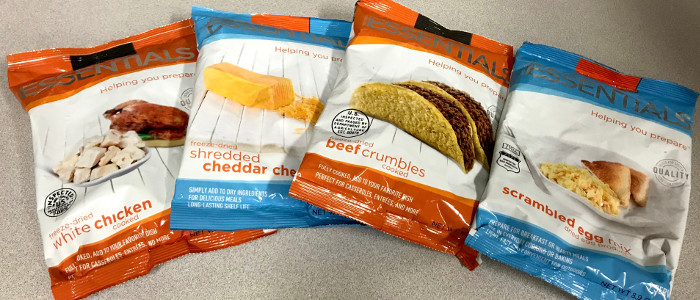
We loved the Premier option because of the supplemental packages of protein — something no other company includes in their core product, usually suggesting (even depending on) them as an additional add-on instead.
Chicken can be added to the rice pilaf or pasta alfredo. Ground beef or cheddar cheese shreds (or both!) can be added to the chili. Scrambled eggs alongside a serving of hot cereal rounds out the nutritional profile, so breakfast isn’t just carbs.
The winner is part of a whole new line from Emergency Essentials, and we were one of the first to see it outside the company. EE tells us they retooled their food offerings to increase nutrition, improve flavor, and cut empty calories.
There are five product levels. We like that EE is taking a transparent approach to make things simpler. Although we do wish they’d use language around one person, instead of four people for 72 hours.
(Editor’s note Oct 2018: It looks like Emergency Essentials has again reorganized their offering. The winning Premier is still available, but some of the cheaper options were consolidated.)
Emergency Essentials’ buckets are a nice size for bugging out for a few days, since you can just grab one of the three buckets and go if you’re in a hurry or have limited space. They stacked well and held up to our package torture tests.
Emergency Essentials taste test review
The food ranked highly among our testers in terms of flavor and texture. It wasn’t the best, but clearly better than average.
Most other products had tiny flecks of the promised vegetables and fruits. The EE bucket has large, identifiable pieces, including whole peas, carrots, etc.
Our taste test panel particularly loved these items:
- Scrambled Eggs with Cheddar (testers loved having a breakfast option that wasn’t just hot cereal or cold granola)
- Rice Pilaf, which had tons of large pieces of vegetables, with added chicken breast.
- Pasta Marinara with ground beef.
- Rice Pudding (testers absolutely loved this!)
We liked the Rice Pilaf because it had actual vegetable content! Whole peas and large slices of carrot. No other company has this much vegetable content, not even Mountain House. With chicken broth, white rice, and a surprising addition of orzo, this meal was excellent, especially with some of the freeze-dried chicken included in the Premier bucket.
Preparation requires simmering in a pot for 15 minutes. When prepared according to the directions, the pilaf is more like soup at the end of the cooking period, but it’s a delicious soup:

If left to sit off the heat with a lid on the pot, it does thicken, but the orzo and rice becomes softer than regular pilaf. To make a rice pilaf, we suggest cutting the water 25% from the directions, and letting the pot sit covered for 15 minutes off the heat after simmering for the time indicated.
The Pasta Marinara cooked up more like a soup than we expected, even though after our experience with other EE entrees. We made this one with only 8 cups of the 10 specified. After following cooking instructions exactly, what we had was soup, even using the smaller amount of water. Simmering another 10 minutes didn’t change much.
After the cooking time, it looked like a brothy soup. We covered the pot and let it sit off the heat for 20 more minutes, resulting in pleasantly chewy noodles in a thin but flavorful tomato sauce. After the additional time, it looked like this:
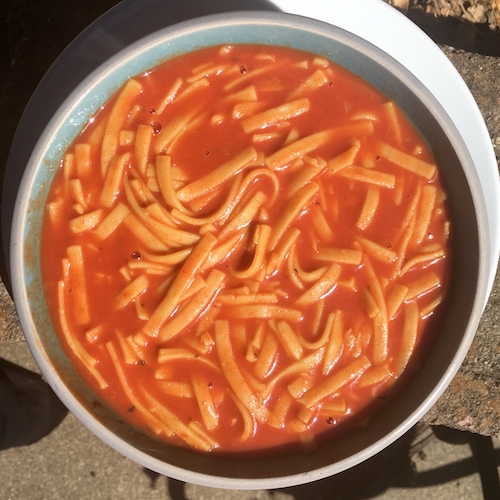
The Pasta Alfredo has a very pleasing flavor, but the sauce tastes more like the gravy in biscuits and gravy, not Alfredo. Specifically, it tastes of salt, black pepper, and flour, rather than parmesan cheese which is the hallmark flavor of Alfredo sauce. Thin noodles with a good consistency (not mushy) in rather a lot of sauce. Tasty and filling, but the flavor profile is confusing.

The Tomato Basil soup has good tomato flavor. Light on the basil. Some testers detected an off-flavor they described as metallic.

Mountain House is great survival food — but pricey

Tasty and convenient:
Mountain House Just-in-Case 14-Day Combo
Pros:
- The best flavor of any comparable product, by far
- Highest in protein and overall nutrition
- Convenient stand-up pouches
- Needs less cooking fuel than other options
- Can be used with cold water
- Doesn’t create any dirty dishes or require a pot
Cons:
- The most expensive, by far
- We really dislike the odd fragmentation among MH product options
- Silly cardboard boxes
- Vaguely labeled plastic buckets and hidden calorie counts
- Not vegetarian-friendly
If you ignore price, the overall best two week survival food is the Mountain House 14-day Just-in-Case Emergency Food Combo. The kits are nutritionally complete, very tasty, and contain convenient pouches and cooking methods.
Note that Mountain House only sells through distributors, so we’ve linked to Emergency Essentials and Amazon ($280).
At $280 to cover one person for two weeks, or $560 for two people, Mountain House is considerably more expensive than the rest. But that extra money buys the most nutritionally complete and best tasting food on the market. So you might compare it against a normal trip to the supermarket, and less so against the cheaper survival food.
Other emergency food we tested ran about $7-10 per day per person, while Mountain House costs over $20 per day. MH knows they’ve got a premium product, and they charge accordingly.
One of the main advantages Mountain House has over competitors is how easy it is to use, especially in an emergency situation. You simply open a pouch, pour in boiling water, zip the pouch closed, wait, give it a shake, eat from the pouch, then throw it away.
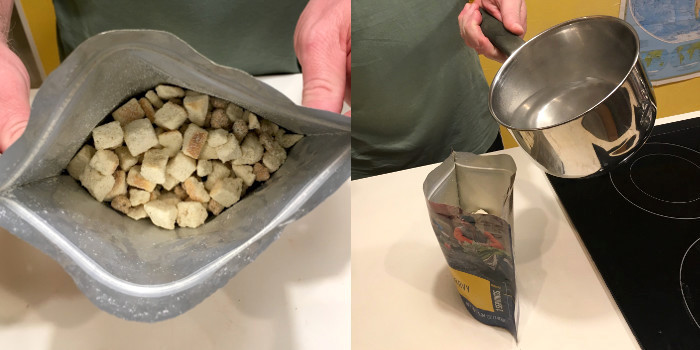
Although many survival companies claim that you can also use cold or room-temp water to ‘cook’ (i.e. reconstitute) the food, we frequently hear from outdoor enthusiasts that MH does better with cold water than the rest. From what we’ve seen, we believe it.
For most other products, you have to boil water in a pot and then add the food packet to the water, letting it simmer until cooked. That requires a pot large enough to cook the food, which makes it difficult with the ultra-light pocket stoves and pots we generally recommend for bug out bags. Plus you end up with dirty dishes.
That extra simmering time means you use a little bit more fuel than just boiling water alone. You also need to pay attention to simmering food, because they will scorch if you don’t stir frequently.
Our number-crunching showed Mountain House had the most protein at 77 grams per day compared to the second-best EE bucket with 73 (including the EE protein packets). The meals had lots of protein, like eggs, sausage, ham, bacon, beef, and chicken. Every item except granola has meat of some kind, so it’s not vegetarian friendly.
Combined with ~2,200 calories per day from an acceptable level of carbs, it has just enough to feel complete and was tops in overall nutrition.
Dr. Polokoff, a nutritionist we consulted, thought so too: “Mountain House offers the best product with respect to balanced macronutrient nutrition.”
And the flavor. Oh, the flavor. Our testers (most of whom were unfamiliar with this product line) were blown away with how good it tasted. Not a single dud in the bunch. One tester proclaimed: “This isn’t emergency food. This is FOOD!”
Every tester said they would keep Mountain House foods in the house to eat as regular food. “It’s actually cheaper than ordering delivery, and it tastes better.”
Packaging, product confusion, and calories vs. servings games
We really dislike the way Mountain House organizes their various product offerings (SKUs). Even when you set aside the individual flavor or ingredient choices, just the variety packs alone come in these “Just In Case” product options:
- 2-day cardboard box: $38
- 3-day cardboard box: $62
- 4-day cardboard box: $80
- 5-day cardboard box: $100
- 14-day combo of the 2-, 3-, 4-, and 5-day boxes: $280
- Classic bucket: $74 (for 3 days’ worth of non-breakfast meals)
- Essential bucket: $65 (for 3-4 days’ worth of non-breakfast meals)
- Breakfast bucket: $90 (for 14 days’ worth of breakfast)
We got the 14-day combo, which was a mix of boxes for 2, 3, 4, and 5 days. We tried to find a silver lining in things being organized that way, such as more fine-grained control over what you could grab to bug out, but we just couldn’t get over it.
This is probably due in part to Mountain House not identifying as a “survival” company, but more of a generalized outdoor company. We get the impression the emergency preparedness market is a bit of an afterthought or bonus for them. Although, most of the other camper/backpacker companies that compete with MH don’t even offer survival packages.
We also dislike how difficult it is to find clear information about calorie counts in the bulk Mountain House packs.
Although the cardboard box options at least make a claim about the number of days covered, the plastic buckets don’t describe days and/or calories at all — just “servings”, which means nothing in this context.
We manually added the calories based on the nutritional labels on each pouch. Mountain House seems to consider a day’s worth of food to be about 2,150-2,200 calories in the boxes labeled by number of days, which is appropriate. So why hide it?
The Classic and Essential buckets are 4,370 and 7,840 total calories, respectively. The Classic is cheaper because although it has more calories, it has less variety — only three flavor options as opposed to six in the Essential.
If one Classic or Essential bucket was all you had to eat, it would only last three days. The Breakfast bucket is 8,100 calories — we’re assuming that MH thinks if you buy a Breakfast and Essential bucket, together that would be 12,470 calories, or roughly six days for one person for $155.
The 2-, 3-, 4-, and 5-day options come in flimsy cardboard boxes that can’t keep out water or stand up to crush damage, so we’d recommend putting the individual packets into a bucket with an airtight seal (Gamma lid).
For such a premium product, MH should do better by reorganizing the product SKUs, making calorie counts clearer, and providing quality storage bins for the 15-30 day emergency packs.
Mountain House tasting review
Every morsel of Mountain House food was inhaled by the testers. Literally, every single product is good.
In Mountain House’s Rice with Chicken, the rice is noticeably different than rice from other companies. It’s toothsome and chewy in a good way, with delicious savory chicken flavoring without a single off-flavor like so many other companies’ products. And it has distinct chunks of real chicken. But we wish it had more than a few flecks of veggies.
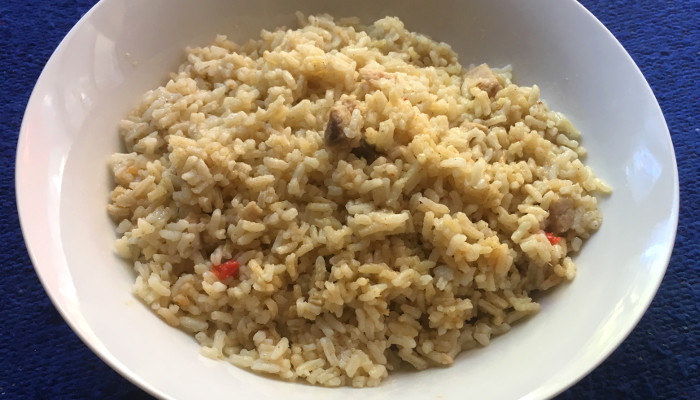
Pasta Primavera … wow! Huge hit. Generous amount of vegetables and a creamy Parmesan sauce. Unlike its competitors, the pasta in this dish isn’t mushy, but has a great, chewy texture in a surprisingly delicious sauce. All testers would eat this as a regular meal, and thought it would be good to just keep on hand as a pantry staple. “The kind of food that makes you hope the power goes out!”
The Italian Pepper Steak has nice, chewy bits of beef, and intensely flavored tomato sauce that’s heavy on the red bell pepper. Most of the testers loved it, and all of them liked it. The only ones who didn’t love it don’t like bell pepper.
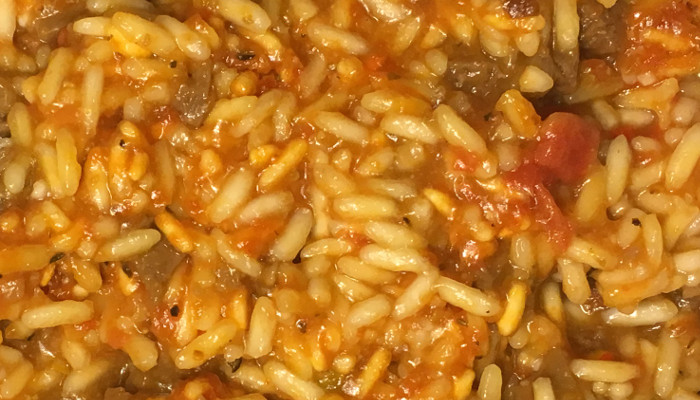
The lasagna had plenty of rich, deeply flavored tomato sauce, chewy noodles, and chunks of ground beef. Extremely well received. Not a bite left behind.
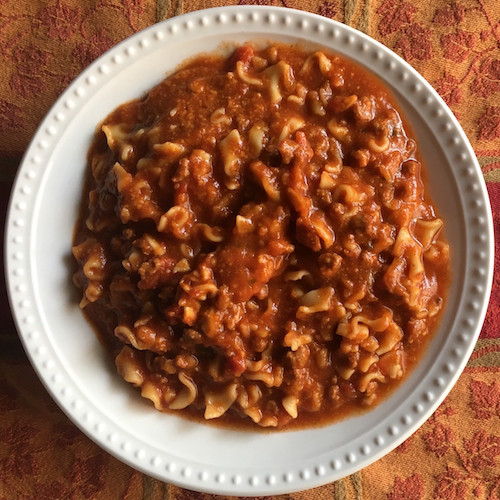
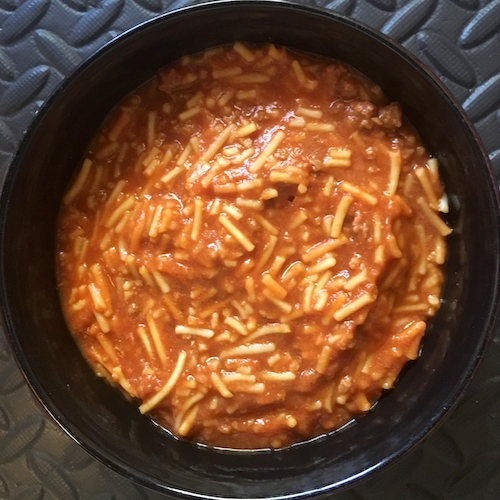
The Chili Mac is good enough for everyday eating, with noodles and beans in a rich chile-flavored tomato sauce. Not a single dud in the bunch. Also, Mountain House breakfasts are made with eggs, and aren’t highly sweetened carb bombs. Mountain House isn’t “will do in an emergency” food. It’s food that will keep a long time in case of emergency.
Their Biscuits and Gravy made fans out of testers who hate biscuits and gravy. So much so, they’ve already ordered some for their emergency food supply.

Best vegetarian emergency survival food: Legacy Foods

Great for vegetarians / base:
Legacy Foods 120 Serving Bucket
Our pick for vegetarians is the $299 Legacy 120 Serving Breakfast Lunch and Dinner bucket. The Legacy food bucket is a good product, with the most attention paid to health and nutrition, although it’s not a contender for our best overall picks. It’s relatively low on calories, covering two people for two weeks at 1,500 calories per day.
This food is completely vegetarian-friendly, non-GMO, has no high-fructose corn syrup, and has a decent amount of fiber for a meatless product at 16 grams per day. It comes very lightly seasoned, which you may dislike or enjoy because it allows you to customize to personal taste.
The bucket itself is the easiest to open and reuse with its large hinged lid. The package has options not found in other buckets, like Hawaiian Style Sweet and Sour, White Bean Chili, and Spicy Corn Chowder. We thought the portions were generous.
Legacy also has a gluten-free bucket, which we didn’t test, but wanted to let you know about. It’s more expensive at $340 for one person for 15-18 days at 2,500-2,200 calories per day, respectively.
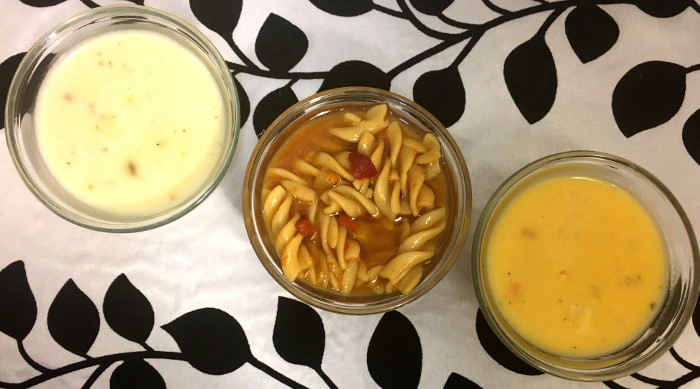
We can hear the grumbling already. Insisting on eating vegetarian during an emergency? That’s crazy! If things get to the point you’re raiding your emergency food stash, being picky about what you eat is ridiculous!
Actually, no. You should be able to keep eating the way you usually do during a short-term emergency. Not just for preference reasons, but to minimize the effect of drastically changing your diet at a time when your body already has enough to deal with.
In a long-term SHTF situation, people will eat whatever food they can find, and be grateful for it.
But when the next big Cascadia Fault earthquake hits, a hurricane makes landfall, or someone has a difficult period due to sudden job loss or medical bills, vegetarians will be glad to have foods they’re used to eating.
Keep in mind that Legacy didn’t necessarily intend to create a product only for vegetarians. It was designed as a base for people to add their own protein, salt, seasonings, and ingredients. Which means Legacy requires more “cooking” than many of the other options we looked at, to the point where some of our testers didn’t think it qualified as “emergency food.”
This company made a deliberate choice to keep the salt and other seasonings subtle (or, as our testers called it, “bland”) so that people can tailor the food to their individual preferences.
Amy from Legacy tells us, “All of our meals are vegetarian. Most companies don’t put enough meat in their meals to satisfy a meat eater. Or they use a cheaper protein such as TVP (textured vegetable protein). While TVP is a great product to keep costs down for companies, Legacy felt this should be a customer choice.”
We appreciate that Legacy is upfront about it and owns their decision instead of dancing around it. But given our criteria for buying nutritionally complete kits with just one click, it took them out of the running for best overall product.
For example, their Stroganoff is just pasta with creamy mushroom sauce, to which you will need to add beef, chicken, or vegetarian protein. Hawaiian Style Sweet ‘n Sour Rice is just rice with vegetables and sauce.
As a meatless product, the protein count might be a little low, so try to include additional sources of protein such as beans or soy. Meals seem to average around 40-45 grams of protein per day.
One of the tasting highlights were the breakfasts: oatmeal, mixed grain cereal, pancakes, and creamy wheat.
They are by far the healthiest breakfast options offered by any of the companies whose products were tested. Low in added sugars, good amounts of fiber, etc. One tester even commented, “Wow! Even flax seeds? That’s great!”
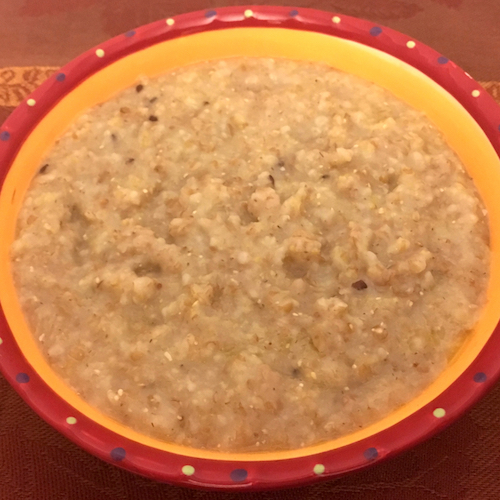
For example, the 9 Grain Cereal was a huge hit among testers who dislike eating sugary desserts in the morning — aka a Typical American Breakfast. This had no sugar, no salt, no chemicals or preservatives. Just nine grains. Hard red wheat, soft white wheat, barley, rye, oats, cornmeal, millet, buckwheat and flax seeds.
Great add-on to any survival food: My Patriot Supply
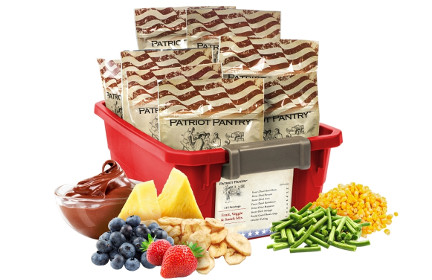
Great add-on:
My Patriot Supply Fruit, Veggie, and Snack Mix
As explained above, none of the prepper food products on the market are nutritionally complete, and many of them lack a meaningful amount of fruits and veggies. Plus, sometimes you just want a quick snack.
Although we looked at a variety of ways to make the single variety packs more complete, including shake mixes and alternatives like Soylent, our favorite is the $100 My Patriot Supply Fruit, Veggie, and Snack Mix.
It comes with non-GMO freeze-dried corn, green beans, broccoli, blueberries, strawberries, pineapple, honey-coated banana chips, and even chocolate pudding.

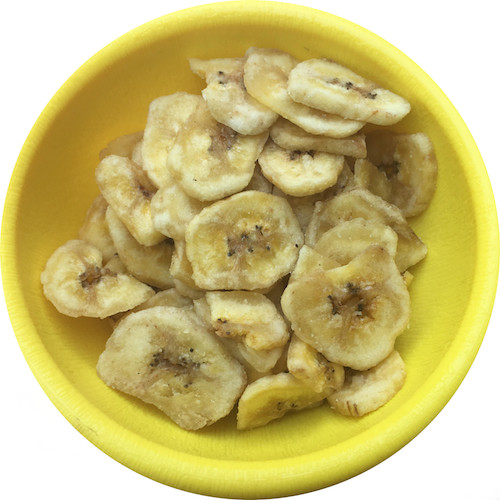
The tote packaging is great for an add-on because it’s easy to store and convenient to reuse. It’s not as sturdy as the buckets, which hurt our review of the main MPS kit for best overall, but we think it’s worth the tradeoff for a supplemental add-on that you want to keep out of the way.
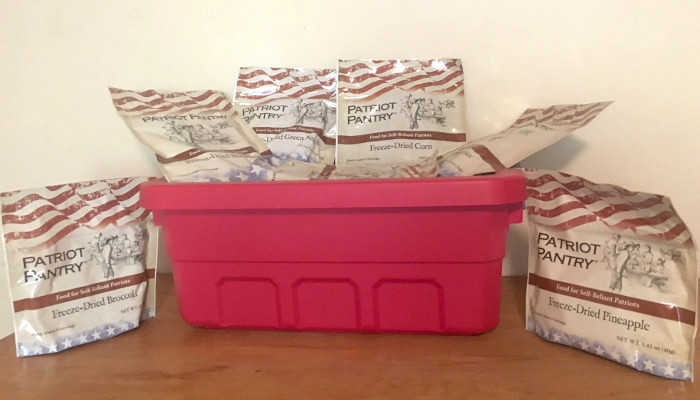
Review notes on the survival food alternatives
Augason Farms 30 Day Emergency Food Pail review
The Augason Farms 30-Day Pail covers two people for two weeks at ~1,800 calories per day for just $99 — making it one of the more cost effective yet acceptable options on the market.
Augason Farms offers a lot of calories for a good price, yet still manages to be in the top half of options for protein and fiber. We also like that they clearly print on the product the total calories and calories per day.
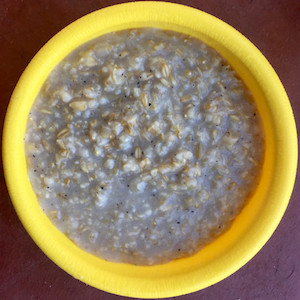
Note that due to heavy demand after the major 2017 hurricanes and wildfires, Augason was unable to send us the 30-day pail. They sent the 1-week and 2-week pail instead, which contained the same meals for testing. We calculated nutritional breakdown using the labels for the 30-day pail.
Augason is a well-known, trusted company that sells products in Walmart and Target, and has loyal fans. Some of the lesser-known prepper food brands actually white-label Augason’s food, putting their own sticker on it.
It was a solid contender, but in the end we thought it lacked variety, and we had concerns about the nutritional content.
Companies have to make tradeoffs when attempting to make food more affordable. In this case, the nutritionist felt the percentage of calories from carbs was too high.
There were some standouts. Their Morning Moo is the best-tasting powdered substitute for fresh milk we’ve tried. The Creamy Potato Soup is something everyone who tried it said they would keep in the house as regular food. It had plenty of diced potato, excellent mouthfeel, pleasant taste of onion/leek, and wasn’t too salty.
The Spanish Rice was rated the best by testers, and impressed people who don’t like processed foods in general. It didn’t have that weird flavor so many emergency foods have (dried parsley and generic soup base). Instead, it tasted of chicken broth, onion, cumin and plenty of red and green bell peppers, with a hint of tomato. Just salty enough.
My Patriot Supply 4-Week Food Supply
The $230 My Patriot Supply 4-Week Tote offers a good assortment of non-GMO food, snacks, a dessert, and a fortified beverage. Each tote has 30,460 calories, so although they market it for four weeks, it’s more like a two-week tote when you get up to 2,030 calories per day.
So one $230 tote will cover one person for two weeks. We wish MPS was more upfront about calorie and nutrition content — neither of which are published on the product’s store page.
MPS stands out by sending food in a plastic tote instead of a bucket. It didn’t hold up to our crush and water tests as well as the buckets, but does have the advantage of fitting under furniture and working great as a reusable storage bin.
Taste testers thought MPS had good flavor, although lacked some variety. Nutritionists found it to be low in protein but high in simple carbs.
We chose My Patriot Supply’s freeze-dried fruits, vegetables and snacks tote as our favorite supplemental add-on. So regardless of what you buy for the main meals, consider the MPS add-on.

A testing highlight is the Pancake Mix. The best of all we tested, it had a pleasing chew and delicate crumb, was slightly sweet without syrup, but had that classic pancake flavor.
Ready Store EasyPrep Ultimate 1-Month Food Kit review
Ready Store’s $198 EasyPrep Ultimate 1-Month Food Storage Kit feeds one person for two weeks at 2,000-2,200 calories per day.
We really like the spirit of what EasyPrep is trying to do: overcome the calories, number of days, and servings marketing gimmicks by simplifying around a “one bucket equals one month for one person” slogan.
But, quite unfortunately, they base their calculations on 1,000-1,100 calories per day. So the 1-Month Kit is marketed for one person for one month, but only contains 31,070 total calories.
We liked that EasyPrep didn’t need as much cooking as other products, which reduces effort and fuel spent. Some of the included food is simple staple ingredients, like mashed potatoes and instant oats, which is nice to combine with stuff from your pantry.
Taste testers ranked EasyPrep in the bottom half. We also found the food to be high in carbs yet low in everything else.
Some tasting highlights: It’s the only company to offer a package of plain, unsweetened instant oats, which the testers really liked, since most of the flavored oatmeal/hot cereal we tested were really, really sweet.
The Apple Cinnamon Granola with Milk, which our tasters loved more than any competitive option, had a nice crunchy texture and great flavor balance. On the flip side, tasters felt the Lasagna didn’t actually look or taste like lasagna — and the first/main ingredient on the package was “corn syrup solids” 🙁
Wise Foods Emergency Freeze Dried Breakfast and Entree Bucket review
At $130 for 19,920 calories, the Wise Foods 84-Serving Emergency Bucket is marketed as a one-month supply for one person, even though it can barely cover one person for two weeks at a relatively small 1,300-1,400 calories per day. For $30-40 more, our main pick from Emergency Essentials delivers over 1,800 per day.
You won’t die of malnutrition, but you won’t be happy or strong. In addition to the low calorie count, nutritionists didn’t like what they saw — another example of cheap food being lower-quality food.
The Wise foods are more convenient to make than some of the others, requiring less active cooking. Just add water, cover, and wait. Easy for kids:

Unfortunately, our taste testers rated Wise the lowest on flavor. However, when we asked testers to consider taste in the context of price, they felt the quality to value ratio was acceptable.
For example, Wise had extremely low levels of fruits and vegetables. This was all of the pea-sized strawberry pieces in an entire package of Strawberry Cereal, compared to this amount of blueberries in the same serving-size of granola from Mountain House:

Some highlights: Apple Cinnamon Cereal had great texture and flavor. Noodle Soup has nice tiny twisty noodles and comforting chicken-flavored broth (just don’t let the soup sit too long, or the noodles get mushy).
The Wise mac and cheese did well in our head-to-head competition, especially with the added bacon flavor. Also, the Wise Shakes taste the sweetest (sugar and aspartame), so tasters liked their flavor the best out of the shakes we tried.
Review of supplemental survival shakes
If you had to rely just on emergency freeze-dried food in buckets, you’d be low on protein and nutrients. One way to supplement those buckets is with fortified meal replacement shakes, so we chose to test products from Soylent, Tsogo, Wise, and Simpli Prepare.
Soylent
At $40 for a case of 12, Soylent does a great job replacing solid meals with pre-mixed drinks that can extend your survival food stores by a few days. Each bottle is 400 calories and contains 20% of your daily nutritional needs. Drink five bottles and you’ve got a full day’s worth. They’re also vegan and nut- and lactose-free, with very clear nutritional info.
The big problem is a short 1-2 year shelf life. If you regularly use Soylent as a meal replacement, you could pick up an extra stash to rotate through, that way in an emergency you’ve got a few bottles around. But you can’t depend on them to survive.
Some of The Prepared’s experts use and love Soylent in everyday life. But there are plenty of people who dislike the taste, and one of our taste testers compared it to oat batter. The Natural flavor was the best received, followed by Cacao. Almost all of the testers didn’t like the Nectar flavor, saying the scent reminded them of perfume, and the flavor was strong and unpleasant.
Tsogo
We tested a $26 pack of 12 Tsogo Fit Natural drinks to evaluate a meal replacement shake that didn’t drive up the carb count just to get more protein and vitamins.
Tsogo has a shelf-life of up to 2 years, but that’s if you store it at 60 degrees or lower at a humidity of 10% or lower. Realistically, the shelf-life is shorter, and the flavor gets really funky when the vitamin powder expires. This alone prevents us from recommending Tsogo.
Tsoso Fit comes in chocolate, vanilla, and natural. The shakes are chalky and very sweet, with 20 grams of plant-based protein and 9 grams of carbohydrates, of which 2 grams are added sugar. Sweeteners listed are honey powder and sucralose.
Testers felt Soylent beat Tsogo on flavor. However, the Tsogo line has a lot of products, such as fruit and vegetable powders and boost packs (protein, caffeine, energy, green tea), so it’s worth checking out. This might be a line of products you want to work into your regular life, so cycling through your supply before it expires would make the shelf-life less of a concern.
Wise Foods
The $90 Wise Emergency Meal Replacement Shakes each provide 260 calories over 40 servings. Because they’re stored in powder form, the shelf-life is 10 years. Testers liked Wise shakes because of the unique Strawberry and Peaches and Cream flavors.
The shakes have more intense flavor and greater perceived sweetness than the others we tested. There is some sugar, but the carb count is low, so that extra sweetness comes from the aspartame. Many food companies are now combining nutritive sweeteners (sugar, honey, corn syrup) with non-nutritive ones (aspartame, saccharine) to mask off-flavors.
Simpli Prepare Shakes
The $85 Instant Triple Berry & Chocolate Shakes didn’t taste as good as other options, but the vendor specifically told us they went for healthy nutrition and shelf-life over flavor. Non-GMO, no added sugar, and clear nutritional info.
The buckets come with shaker bottles, packets of powdered shake mix, and algae oil in separate bottles. The main powder has a 10 year shelf-life, but the algae oil only lasts for 2 years. But the company will replace unopened, expired oil bottles with new ones for free.
Using the included shaker bottle, pour water in up to the etched measuring line. Then add shake powder and some algae oil, screw the lid on, and shake well. It’s a good meal replacement or protein supplement with 15 grams of pea protein per serving.
Simpli Prepare Soups
We tried the $85 Instant Loaded Potato & Cheesy Broccoli Soup from Simpli Prepare because soup might be an easy way to supplement the main survival meals. The soup is packaged the same way as the shakes, with a shaker bottle and algae oil, and with the same directions. The vendor confirmed this is meant to be a “just add water” product, not a simmer and serve hot sort of thing, and suggests using hot water from the tap if possible.
We found the shakes to be more successful, flavor-wise, than the soups, but it’s nice to have a non-sweetened liquid meal. If you can get used to the idea of a room temperature soup-smoothie, this is a nice option.
